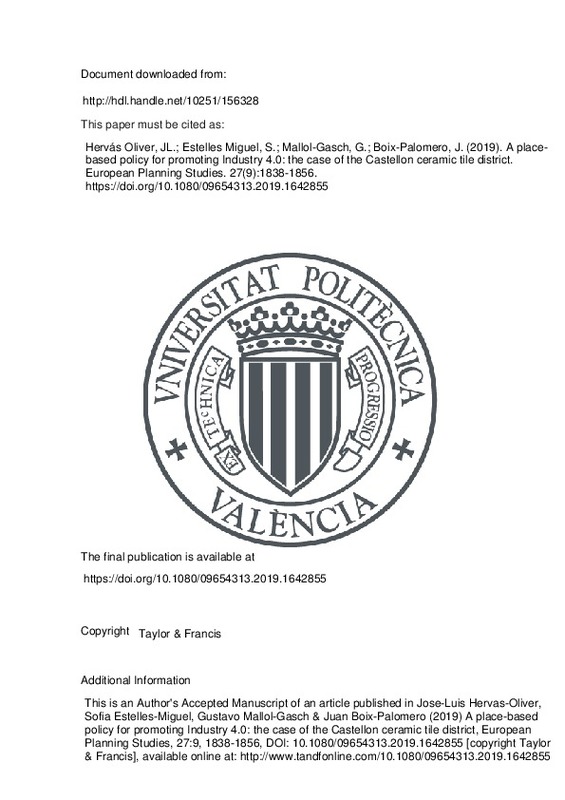Aldrich, H. E., & Fiol, C. M. (1994). Fools Rush in? The Institutional Context of Industry Creation. Academy of Management Review, 19(4), 645-670. doi:10.5465/amr.1994.9412190214
Alvedalen, J., & Boschma, R. (2017). A critical review of entrepreneurial ecosystems research: towards a future research agenda. European Planning Studies, 25(6), 887-903. doi:10.1080/09654313.2017.1299694
Anderson, P., & Tushman, M. L. (1990). Technological Discontinuities and Dominant Designs: A Cyclical Model of Technological Change. Administrative Science Quarterly, 35(4), 604. doi:10.2307/2393511
[+]
Aldrich, H. E., & Fiol, C. M. (1994). Fools Rush in? The Institutional Context of Industry Creation. Academy of Management Review, 19(4), 645-670. doi:10.5465/amr.1994.9412190214
Alvedalen, J., & Boschma, R. (2017). A critical review of entrepreneurial ecosystems research: towards a future research agenda. European Planning Studies, 25(6), 887-903. doi:10.1080/09654313.2017.1299694
Anderson, P., & Tushman, M. L. (1990). Technological Discontinuities and Dominant Designs: A Cyclical Model of Technological Change. Administrative Science Quarterly, 35(4), 604. doi:10.2307/2393511
Bailey, D., Pitelis, C., & Tomlinson, P. R. (2018). A place-based developmental regional industrial strategy for sustainable capture of co-created value. Cambridge Journal of Economics, 42(6), 1521-1542. doi:10.1093/cje/bey019
Barca, F., McCann, P., & Rodríguez-Pose, A. (2012). THE CASE FOR REGIONAL DEVELOPMENT INTERVENTION: PLACE-BASED VERSUS PLACE-NEUTRAL APPROACHES*. Journal of Regional Science, 52(1), 134-152. doi:10.1111/j.1467-9787.2011.00756.x
Bell, M., & Albu, M. (1999). Knowledge Systems and Technological Dynamism in Industrial Clusters in Developing Countries. World Development, 27(9), 1715-1734. doi:10.1016/s0305-750x(99)00073-x
Belso-Martinez, J. A., Diez-Vial, I., Lopez-Sanchez, M. J., & Mateu-Garcia, R. (2018). The brokerage role of supporting organizations inside clusters: how does it work? European Planning Studies, 26(4), 706-725. doi:10.1080/09654313.2017.1422482
Belussi, F., & Sedita, S. R. (2009). Life Cycle vs. Multiple Path Dependency in Industrial Districts. European Planning Studies, 17(4), 505-528. doi:10.1080/09654310802682065
Deephouse, D. L. (1996). Does Isomorphism Legitimate? Academy of Management Journal, 39(4), 1024-1039. doi:10.5465/256722
DiMaggio, P. J., & Powell, W. W. (1983). The Iron Cage Revisited: Institutional Isomorphism and Collective Rationality in Organizational Fields. American Sociological Review, 48(2), 147. doi:10.2307/2095101
Eisingerich, A. B., Bell, S. J., & Tracey, P. (2010). How can clusters sustain performance? The role of network strength, network openness, and environmental uncertainty. Research Policy, 39(2), 239-253. doi:10.1016/j.respol.2009.12.007
Feldman, M., & Lowe, N. (2018). Policy and collective action in place. Cambridge Journal of Regions, Economy and Society, 11(2), 335-351. doi:10.1093/cjres/rsy011
Foray, D. (2016). On the policy space of smart specialization strategies. European Planning Studies, 24(8), 1428-1437. doi:10.1080/09654313.2016.1176126
Gabaldón-Estevan, D., Manjarrés-Henríquez, L., & Molina-Morales, F. X. (2018). An analysis of the Spanish ceramic tile industry research contracts and patents. European Planning Studies, 26(5), 895-914. doi:10.1080/09654313.2018.1427701
Gilbert, B. A. (2012). Creative destruction: Identifying its geographic origins. Research Policy, 41(4), 734-742. doi:10.1016/j.respol.2011.11.005
Glasmeier, A. (1991). Technological discontinuities and flexible production networks: The case of Switzerland and the world watch industry. Research Policy, 20(5), 469-485. doi:10.1016/0048-7333(91)90070-7
Hervás-Oliver, J. L., & Albors-Garrigós, J. (2007). Do clusters capabilities matter? An empirical application of the resource-based view in clusters. Entrepreneurship & Regional Development, 19(2), 113-136. doi:10.1080/08985620601137554
Hervas-Oliver, J.-L., & Albors-Garrigos, J. (2008). The role of the firm’s internal and relational capabilities in clusters: when distance and embeddedness are not enough to explain innovation. Journal of Economic Geography, 9(2), 263-283. doi:10.1093/jeg/lbn033
Hervas-Oliver, J.-L., & Albors-Garrigos, J. (2014). Are technology gatekeepers renewing clusters? Understanding gatekeepers and their dynamics across cluster life cycles. Entrepreneurship & Regional Development, 26(5-6), 431-452. doi:10.1080/08985626.2014.933489
Hervás-Oliver, J.-L., Albors-Garrigos, J., Estelles-Miguel, S., & Boronat-Moll, C. (2017). Radical innovation in Marshallian industrial districts. Regional Studies, 52(10), 1388-1397. doi:10.1080/00343404.2017.1390311
Hervas-Oliver, J.-L., Lleo, M., & Cervello, R. (2017). The dynamics of cluster entrepreneurship: Knowledge legacy from parents or agglomeration effects? The case of the Castellon ceramic tile district. Research Policy, 46(1), 73-92. doi:10.1016/j.respol.2016.10.006
Hervas-Oliver, J.-L., Sempere-Ripoll, F., Estelles-Miguel, S., & Rojas-Alvarado, R. (2019). Radical vs incremental innovation in Marshallian Industrial Districts in the Valencian Region: what prevails? European Planning Studies, 27(10), 1924-1939. doi:10.1080/09654313.2019.1638887
Hervas-Oliver, J.-L., Sempere-Ripoll, F., Rojas Alvarado, R., & Estelles-Miguel, S. (2017). Agglomerations and firm performance: who benefits and how much? Regional Studies, 52(3), 338-349. doi:10.1080/00343404.2017.1297895
Liao, Y., Loures, E. R., Deschamps, F., Brezinski, G., & Venâncio, A. (2018). The impact of the fourth industrial revolution: a cross-country/region comparison. Production, 28(0). doi:10.1590/0103-6513.20180061
Robertson, P. L., & Langlois, R. N. (1995). Innovation, networks, and vertical integration. Research Policy, 24(4), 543-562. doi:10.1016/s0048-7333(94)00786-1
Saxenian, A. (2014). The Silicon Valley Model: Economic Dynamism, Social Exclusion. Reconceptualizing Development in the Global Information Age, 28-51. doi:10.1093/acprof:oso/9780198716082.003.0003
Scott, A. J. (1992). The Roepke Lecture in Economic Geography the Collective Order of Flexible Production Agglomerations: Lessons for Local Economic Development Policy and Strategic Choice. Economic Geography, 68(3), 219. doi:10.2307/144183
Sine, W. D., & Lee, B. H. (2009). Tilting at Windmills? The Environmental Movement and the Emergence of the U.S. Wind Energy Sector. Administrative Science Quarterly, 54(1), 123-155. doi:10.2189/asqu.2009.54.1.123
Staber, U., & Sautter, B. (2011). Who Are We, and Do We Need to Change? Cluster Identity and Life Cycle. Regional Studies, 45(10), 1349-1361. doi:10.1080/00343404.2010.490208
Stam, E. (2015). Entrepreneurial Ecosystems and Regional Policy: A Sympathetic Critique. European Planning Studies, 23(9), 1759-1769. doi:10.1080/09654313.2015.1061484
Tan, J., Shao, Y., & Li, W. (2013). To be different, or to be the same? An exploratory study of isomorphism in the cluster. Journal of Business Venturing, 28(1), 83-97. doi:10.1016/j.jbusvent.2012.02.003
York, J. G., Hargrave, T. J., & Pacheco, D. F. (2016). Converging Winds: Logic Hybridization in the Colorado Wind Energy Field. Academy of Management Journal, 59(2), 579-610. doi:10.5465/amj.2013.0657
[-]







![[Cerrado]](/themes/UPV/images/candado.png)


